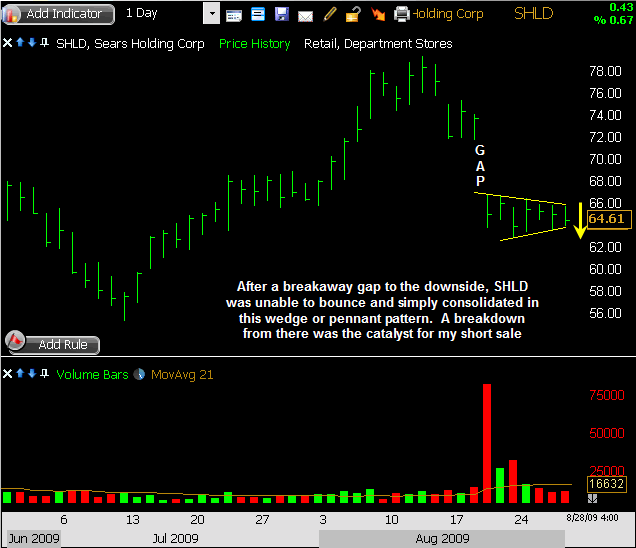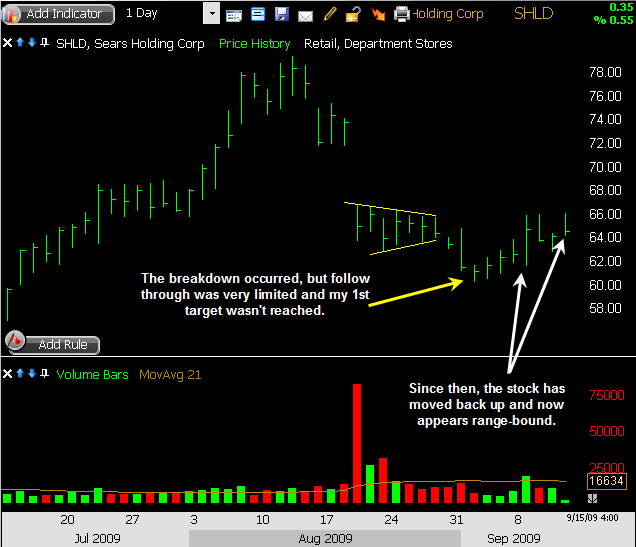Search Results for 'traders'
Implementing the Time Stop
Staying patient with a position can sometimes pay off nicely. After all, not every trade works out exactly when we want it to. It might require a little more time than we originally expected before we see that P&L turn the shade of green we were looking for, and it’s sure nice when that happens.
But there is a flip side to the coin.
Sometimes you can be overly patient with a trade, giving it more and more time (dare I say too much?), just waiting for it to make its move. And I’m not referring to letting it move farther and farther against you – you know better than that!
I’m talking about the trade that simply goes nowhere.
Fortunately, there is a solution to the flatlining trade, which is to implement a time-based stop. This is essentially a countdown placed on the trade, that if nothing happens by a certain time, then either an adjustment is made to stop & target levels, or the trade is simply closed out. You know – so you can move on with your life!
After all, why tie up capital in a position which isn’t performing as expected? Kicking a stagnant trade to the curb can translate into more money to be put toward another opportunity, plus it enables us as traders to put our attention toward something more worthwhile.
Show Me the Money!
Just this week I faced this dilemma. I was swing trading SHLD on the short side due to the breakdown from a bear pennant pattern (see chart 1 below), but aside from the initial weakness, there was no follow through (see chart 2 below).
I had designated 2 targets for my exit, and of course 1 stop loss in case the stock reversed and went back above resistance, but none of those levels were reached. The stock refused to go down far enough for me to start booking profits (according to my trading plan), and yet it wasn’t bouncing enough to stop me out either.
Chart 1:
 StockFinder Chart courtesy of Worden
StockFinder Chart courtesy of Worden
Chart 2:
 StockFinder Chart courtesy of Worden
StockFinder Chart courtesy of Worden
Although SHLD was certainly underperforming the market, and I felt confident if market weakness ever arrived that SHLD would crack pretty good, that never happened. The stock simply formed a trading range, and I began to realize it was essentially a stagnant trade.
Time to Move On
Over the weekend, I decided I’d give the stock through Monday before making any moves, and so when it remained in its range, I tightened my stop heading into Tuesday, and today as the stock reached my adjusted stop I closed the position for a minor loss.
I know what some of you are thinking… Why give up on what might eventually develop into a good trade?
Don’t think of this as surrendering or giving up on a trade, because I know that can be difficult for traders who don’t mind being patient. Rather, consider it your responsibility as a trader to keep your capital working for you in the best manner possible.
That means putting it at risk when there’s a good possibility of profiting, and it means protecting it from risk when that potential isn’t present.
The longer we’re in a position as traders, the more we become exposed to company-specific, unplanned news…a surprise, if you will. Leaving a position at risk indefinitely raises the likelihood that news will eventually push the trade one way or the other. The problem with that is that a trade initiated from a technical standpoint should not evolve into a trade which is hopeful for news to make it move. We want real selling or buying to be the deciding factor, and when that turns stagnant then the basis for the trade is negated.
So as you work through your position sheets this week, consider whether some of those stocks are merely resting or if instead they’ve completely lost momentum and are now simply range-bound.
Do your best to determine if a little more patience is needed, or if instead a little less patience is warranted. Time is money, especially for a trader. It might be time to put that trade on the clock and set a deadline. A far better trade just might be waiting for you.
Thanks for stopping by and I’ll see you here soon with more. Until then…
Trade Like a Bandit!
Jeff White
Are you following me on Twitter yet?
Stack the Odds for Daytrading Success
Trading is all about stacking the odds for success. Risks must be taken in order to get paid, but the key is gauging under which circumstances the potential reward really outweighs that risk.
I discussed taking risks in a recent post, and I felt that a follow-up and an example of what I was referring to was in order. Here it is.
Many of my trades are continuation plays. They can be great for offering situations which warrant putting some money on the line once clues of a continued move are present.
However, there are many opportunities on the intraday timeframe which are exhaustion/reversal kinds of setups.
Buy or sell programs, news, and just plain old momentum drive stocks far beyond the pain thresholds of traders, carrying price a considerable distance in one direction or the other. That opens the door for some recoil, and catching the turning point can be quite lucrative.
Stacking The Odds
Here in a moment, I’m going to show you exactly what I mean in a video, but first let me outline a few keys which combined to produce a great trade in this situation.
- Corresponding market action. With the indexes having a distinct possibility of a short-term turnaround, conditions were ripe for similar price action in individual stocks. This is a point I make over and over in the weekly index videos.
- Prior key level on the daily chart of this stock was being tested. A huge intraday move which carries price right to a previously important level on the daily chart will increase the odds for a quick recoil move.
- Intraday price action suggested the move was becoming exhausted. That indicated that a reversal could quickly develop in the stock.
Here’s a video explaining it. Select the HD option and go full-screen for best quality:
Stack multiple factors in your favor for a great trading situation. They’re worth waiting for!
Trade Like a Bandit!
Jeff White
Producer of The Bandit Broadcast
Taking Risks
It’s a known fact that in the market, you get paid to take risks. We all know that, right?
But are you getting the proper rewards for those risks? Are you taking the most appropriate kinds of risks? And perhaps most importantly, do you recognize the extent of the damage which can be done when you take on risks which are larger than you can handle?
I’m in the midst of re-reading a great book on risk right now (I’ll put up a post before too long about it, because it’s something you should read), and it’s got my wheels turning. I’m reconsidering exactly what is risk, how much I should be taking, and why I need to embrace it.
Before sharing too much about the book, let me share with you a couple things which are on my mind right now, and I’ll lay out the rest in a later post once I’ve finished the read.
Defined Risks are the Best Kind
Option traders often refer to their ‘max risk’ on a given trade, because on some strategies they are able to truly limit their downside risk to a set amount. If they’re long premium, the most they can lose is 100%, for example.
But an equities trader like me needs to think in terms of a different kind of risk factor. Yes, I could buy 1,000 shares of XYZ at $20 per share, and my max risk (in terms of capital outlay) would be $20,000. But that’s not realistic risk, because it’s so incredibly unlikely that stock is headed to $0 – especially over the course of a few days when I’d expect to be in the trade.
Instead, it’s important when trading stocks to think in terms of max $ risk if the trade fails (not if the underlying company fails). I touched on this concept of dollar risk per trade earlier this month, but let’s look a little closer at it. If I know my entry and I can designate a stop loss on the trade, then barring any drastic circumstances I’ll be able to exit at or very near that stop should an adverse move occur. That’s the risk I want to be familiar with. The kind of risk that says “if this trade doesn’t work out, what do I stand to lose?”
That’s very different from simply looking at every trade from a capital outlay perspective. It’s a major shift for some of you to start thinking this way, but it can also make a major impact on your trading to implement it.
Know Your Exit
Making what could turn out to be a difficult decision before getting in the heat of the moment can be the most important part of your trading plan. It’s one thing to hunt for entry after entry, locating breakout levels and spots where trend lines could get broken, but it’s an entirely different thing to know where you’ll look to exit that same trade, whether it moves in your favor or not.
I’ve said before that a good trade is usually a planned trade, and that definitely involves knowing your exit from the outset of the play. So before you place that order to enter your next trade, decide on where you’ll get out of it. Set a bracket order or jot it down, or at least verbalize it somehow! That’s still better than thinking you’ll get around to it later. Don’t procrastinate – decide on an exit.
Have a Goal
There is no reward without risk, and there should be no risk without reward. Knowing this, there’s absolutely no reason why each trade shouldn’t have some favorable objective associated with it, so set a goal for each trade. A realistic one that could quite feasibly be reached during the course of the trade.
Perhaps you’ll set a hard target and book profits once that level is reached regardless of how strong the momentum seems at the time. Or perhaps you’ll plan to book partial profits at intervals along the way.
At the very least, having some idea of a level where your stock could move to is still going to help you formulate a game plan, even if you don’t choose to leave a resting order in that zone to book profits.
If you know your stop and you have some kind of upside expectation, then you’ll have a far better grasp of just what your risk is on a given trade and whether or not it should be taken.
Thanks for stopping by and I’ll see you here soon with more. Until then…
Trade Like a Bandit!
Jeff White
21 Questions from Last Week’s Chat
Last week’s trader chat generated quite a few questions. A number of them we were able to address during the chat, but many more went unanswered.
If you were in attendance and didn’t get your question answered, look for it below. But even if you weren’t there, hopefully you’ll find this useful to observe.
Here are 21 unanswered questions from the session:
1. Footbargain: Jeff, what kinds of things do you look for to “trade the trader?”
- Thanks for your question Footbargain. I wrote about this 3 1/2 years ago, and I still think it’s a very good exercise to regularly consider the flip side of your trade. Obviously “they” are looking for a move in the opposite direction as you, but weighing their possible reasons, emotions, and technical exit criteria can really shed a lot of light on what it is you’re up against. Of course, you’ll need to abide by your own designated levels on each trade, but understanding when the other side may get frustrated or overconfident can certainly give us a better feel for the trade and whether or not it deserves to be on our screen.
2. Tom: Greetings Jeff, assuming we do get the “inevitable pullback,” what support levels would you be looking at to re-enter long positions?
- Hi Tom! Using levels from the S&P 500, spots which have served as resistance or support in recent months would mark logical areas for other buyers to step in. The ones I’m watching are 956 and 875. I might add that if the market is selling off sharply into those levels I would not look to jump out in front of it. Some stabilization in those areas would have far greater appeal.
3. Jeff: Hey Jeff, I’m a paid subscriber and I do like your work. Is Worden the main charting software that you use?
- Yes Jeff, TeleChart and StockFinder are the only charting programs I use. I’ve found them to be very powerful and robust programs which offer many more features than I could ever possibly utilize, and yet they’re very simple to use.
4. Dharm: Do you believe it is a bear rally? Or are you in agreement a bull trend has begun?
- Hi Dharm, this really is a timeframe-based question, which leaves it open-ended. In the short term and intermediate term, we’re without question in bull market mode. The move up from the lows has exceeded 50%, which certainly qualifies as a bull market for me. However, zooming out to the long-term timeframe, we are still well off the highs set less than 2 years ago. We also on the long term timeframe have yet to pull back and produce a higher low, so for that timeframe I’m reluctant to classify this as a technical trend change yet (although I do think it will ultimately result in one).
5. Ken: On stops being too tight, where would you place percentage wise on entry? How often do you adjust the stop once you’re in the trade?
- Hi Ken, check out this post on stop loss placement for adjustment purposes(also includes links to prior stop loss posts which you may find helpful). When it comes to the entry, I don’t have a set percentage I go by. Rather, I’m going to base it on the chart, and most notably a failed pattern. For some setups that might mean 3%, for others it might mean 6%, so it will vary.
6. Ron: Do you ever stay with the levered ETF’s more than a day, say a week?
- I do trade them in retirement accounts that way Ron, although I don’t want them to become long-term holdings. What I prefer to do is start a position when I think the market is at an important turning point, then do my best to stick with that trend until it seems to have exhausted itself. I have done well with the levered ETF’s in this fashion, and because they’re also optionable I don’t mind selling calls against them along the way.
7. Julie: I have lightened up significantly during the past three days. The long I do have is an ETF. How far down would you be comfortable seeing a pullback on the S&P?
- Hi Julie, I wouldn’t at all mind seeing a pullback reach the 956 zone or even 875 again (a level which has proven itself several times over the past year). When it comes to your trade though, your original basis for entry and the timeframe you intended it to be should be the biggest consideration. If it’s worked out well for you, then be sure to retain the bulk of those gains. That may mean a partial sale up here after the run, or it may mean raising your stop, or a combination of the two. I’ve found in my own trading once I start getting uneasy with a trade that it’s probably time to draw some lines in the sand and ensure that I get paid from that winning trade without giving it too much room back down should a pullback happen to arrive sooner than later.
8. BullishBeauty: Jeff, I do believe the correction is coming and I’ve lightened up as well. Question is when a position gets to almost profit today, close it or hold til Monday?
- Hi BullishBeauty! This question was referring to last Monday, so since we now have that hindsight let me instead address this from a conceptual standpoint. When you’ve designated a target which is nearly reached but not quite, it’s decision-making time. You either (A) stay patient and allow the stock to move away from that target and trust that it’ll eventually move through it, or (B) you recognize that your target may have been just a little too aggressive, and that therefore you should book (at least some of those) profits now. My tendency is to go with choice B since I like to keep my capital turning over frequently and I like to ring the register often. If you’re a more patient trader, the former scenario may be the way to go. I do want to stress though, that whichever you choose, be consistent in it! That way you’re decisive and the law of averages will run its course.
9. Charles: For the rookies can you explain the price and volume you use?
- Hello Charles. I really like to focus on these 2 things, as they are the most important. All else is derived from them, so they are the source of technical info for us as traders. Price is of course where the stock is currently trading, but it’s also the price action. I like to see how price is moving. Is it moving fast, is it moving steadily, is it indecisive and confined to a trading range of some sort? Basically, who is winning the battle? And with volume, I want to see how it corresponds to price. Is volume spiking as price climbs? If so, it indicates to me that there’s a lot of participation among buyers and that therefore the move may have further to go. Volume is the fuel that propels prices higher, so the more gas that’s in the tank, the farther it can go.
10. Tom: Jeff, can you offer some relevant scanning criteria for day/swing trading?
- Hi Tom, this is something I get asked quite often. For me, I don’t rely heavily on scans to locate the plays I take. What I actually do is start with all the stocks out there, then knock off some huge chunks of stocks which I know I don’t want to trade. Those are the low-priced, illiquid stocks which hold no appeal to me as a trader. By eliminating those, I get stocks with the ability to fluctuate regularly and which carry adequate volume for trading actively (I want plenty of buyers when I’m selling and plenty of sellers when I want to buy). This generally means I’ll eliminate single-digit stocks and anything with fewer than 500,000 shares traded on an average day. That still gives me a large list of stocks, and from there it’s a matter of spending the time to eyeball the list, extract the setups with some potential, and continually refine the list until I get some trading candidates.
11. Dirk: Hi Jeff & Charles…first of all thanks a lot for this great opportunity to share your knowledge with us. I have a very general question regarding position sizing: Given a certain allocation of money to swing trade, and based on that amount, a fixed amount (like 8-10%) one is willing to risk on a trade, is a large position (cheaper stocks) with a tighter stoploss preferable over a smaller position (higher priced stocks) with a wider stop loss?
- Hi Dirk, thanks for your nice comment and this question. There really is no right answer here, as it will simply boil down to your own preference. Give each style a try and see which one works best for you. And I should clarify, that isn’t necessarily based upon the stock’s price, but rather how tight the pattern is that’s being traded. I’d say it will really depend on your personality. If you’re a patient trader and don’t mind waiting for a move to develop over the course of several days to several weeks, then wider stops are suitable. If on the other hand you’d rather keep your money moving more often, then the tighter stops and more of a ‘base hit’ mentality for more frequent but smaller moves would be appropriate. Personally, I fall into the latter category of tighter stops as I prefer to know rather quickly whether I’m right or wrong in the play.
12. Brian: What event do you think could cause the second leg down?
- That’s a great question Brian. I suppose it could be economic data which begins to disappoint, or it could be that the prospects for growth begin to subside and a wave of profit-taking evolves into a deeper correction. I honestly don’t know what it might be, but I’m also not a macro guy. I figure sticking with the technicals will tell me all I need to know (when momentum slows, when selling pressure intensifies, when dips fail to get bought aggressively, etc.).
13. Jon N: I have a stock purchased as a medium to long term holding. At what point would you consider changing this position and just taking profits (I am using trailing stops to protect profits)?
- Hi Jon. I’m big on beginning with the end in mind and therefore knowing an exit strategy before entering a position. Perhaps you designated some targets for this position when you initiated it, so I’d encourage you to stick with them. But if you did not, then as I told Julie, I’d encourage you to weigh your comfort level in the trade. If you’re getting uneasy about possibly giving back substantial open profits, then make some of those paper gains real by selling a portion of your position. There’s some real value in making partial sales. By lightening up into strength, you’re booking profits and raising cash to be re-allocated after a pullback takes place. Having cash on hand after some widespread weakness sets in will be a great thing, and although many have forgotten right now that the market can still go down, they’ll eventually be reminded. So I’d say once you’re uneasy, sell some and designate a stop for remaining shares as a safety net on the rest.
14. Erb: I have witnessed a lot of traders who I deem to be professional traders use terms like “I really just don’t have the feeling today” or another example would be what you just mentioned confidence. I find these terms confusing as I do my best not to trade emotionally. The chart is what it is, the price action is what it is. So as a newbie again I find this quite confusing. Not sure what is meant by the “feeling” or confidence if we are supposed to just trade what we see?
- Hello Erb, this is an excellent question. And I never want to be confusing, so allow me to explain. Newer traders don’t yet have a basis for ‘confidence’ or ‘feeling.’ Those both come over time after many many trades and lots of time spent watching the market. Observing it closely over time will develop the occasional “I’ve seen this before” moments which will then play a role in the decision-making process. But early on in one’s trading career, you are correct in that trading what you see should be the sole basis for decisions. I also do not advocate trading emotionally, but what I’m saying here is that over time as you develop a feel for the markets, that will become part of what you see.
15. George: How do you build your watch lists for swing trades or longer?
- Thanks for your question George. Beyond my comments for #9 and #10 above, it really is a process of digging through the charts to find setups which are being constructed and then weighing the risk/reward associated with each of them. What I do is spend considerable time nightly to hunt through hundreds of charts, designating the occasional stock to be reviewed again. The second run through will be on that limited list of stocks which seem to be exhibiting some momentum and/or are behaving as if they’re ripe for a move. I’ll draw my trend lines to clarify the pattern being built, then I’ll gauge the urgency of the pattern based on price and volume in the most recent days. Once I weigh that and decide if there’s a clear-cut entry and exit for the play, then I’ll set up the swing trade. The key here though is that when I’m swing trading, I understand my entry, stop, and target levels before I place that bracket order for the trade.
16. Juergen: Jeff, I often get stopped out because of too tight stops. I do this because I don’t want to lose money when I’m positive. Any advice to change this (set a wide stop first and narrow it down when the stock moves in my direction)?
- Hello Juergen, I’m glad you asked this. Getting shaken out of trades frequently can be frustrating, unless it’s an acceptable part of your methodology. For example, the trader who takes many small losses but catches the occasional huge winner can be just fine over time. But it sounds like you’re not satisfied with that so let me offer a suggestion. First, cut your trade size in half. Ultra-tight stops and the fear of losing tend to come along with positions which are too large, so change that first. Next, start setting wider stops. Consider how much the stock in question tends to move on an average day, or set stops beyond short-term support zones. That will allow the stock to fluctuate normally and keep you in the trade longer, taking you out only once the stock has truly shown a change of character.
17. Naif: Jeff, can you name a couple of your favorite books on trading?
- You bet Naif. Jack Schwager’s Market Wizards series is excellent. They are each interview-style books where each chapter is a conversation with a different trader. There are many markets, timeframes, and styles represented in those books, and they offer a ton of insight. Another book is by Martin Schwartz and is called Pit Bull
. He was in a Market Wizards book, and his candid story offers a ton of value, making it another excellent read. Nicolas Darvas’ How I Made $2,000,000 In The Stock Market
also is one of my favorites. He shares the tough early beats of his trading career and explains how he devised a method to avoid making his most common mistakes, leading him to big success. Finally, Edwin Lefevre’s Reminiscences of a Stock Operator
is right at the top of my list when it comes to favorite trading books. A very old book, it carries with it countless lessons applicable to today’s trading, making it a timeless book and a must-own. I’ve read each of these multiple times and I gain something new from them each time I re-read them!
18. Eric: It looks to me like a blow-off top in FUQI. Am I reading this right?
- Hi Eric. FUQI has certainly been a huge mover in recent months, and it’s gone parabolic in recent weeks. As you know, the largest moves tend to occur during parabolic uptrends, but trading them also involves added risk. Currently the stock is basing between $26-30, but I have no desire to call a top there yet. Although a sharp drop could develop there at any time, the momentum train is running and deserves respect. If you’re long, this is a great spot to do some selling, but if you’re looking to initiate a short sale, then waiting for some confirmation of a top (with the formation of a lower high) would be best.
19. John: Jeff, to develop your style of trading, did you do backtesting or did you mainly use trial and error?
- Hello John, thanks for your question. Truth be told, I am not a proponent of backtesting. I believe that might reveal some insights for what has historically happened when certain conditions are present, but when it comes to basing confidence of trades on what data says, it’s incredibly difficult to make the transition. Backtesting involves no emotion, and yet trading carries with it a lot of emotion, so there’s a major disconnect there in my opinion. Instead, I go with trial and error, or what I recently referred to as testing 1-2-3. When I have real money on the line, I will learn faster and more intently than simply reviewing data. By doing this, it also elevates my trust in a certain methodology over time, whereas taking a computer model and converting it into trading a real account is a very different story.
20. Jay: Can you speak a bit about how you track your trades, and do you use a trading journal? Thanks.
- Hi Jay. I’ve always noted my trades on a sheet of paper, an actual grid marking several conditions (Time, Prices, P&L, etc.). Noting the reasoning for a trade, what was thought about it during the trade, and of course having the hard numbers to help calculate a variety of things tied to one’s results are imperative to have in my opinion. My newsletter also serves as a diary of sorts for me, as I note each day when I’m in swing trades what I like or dislike about the price action and why I’m adjusting my stop. So that’s my current system. For those who would rather automate this process, there’s an excellent tool called StockTickr which can import trades from various brokers and is capable of generating all kinds of reports tied to your results data. It’s a great way to see visually what’s working and what isn’t, usually shown to you in a different light than you’ve ever considered.
21. Benjamin: Hi Jeff, thanks for doing the Friday chat and am really enjoying it. What do you make of the relatively light trading volumes in the last few weeks, especially in the face of rising stock prices? Do you view them as bullish or bearish signs or neither?
- Hello Benjamin, I’m happy to have had the chance to do the chat (and this follow-up). With the relatively light trading volumes, I think there are a few factors there. One is that there’s a lot of contentment in the market. Prices keep rising, volatility is very low, and therefore fewer see the need to take action on the sell side. So traders accumulate gradually, and we see some lighter volume than we saw last fall when the bottom was falling out. Another factor is that it’s summertime, and that’s just common. Traders take vacations, leaving fewer at their desks to buy and sell, and resulting in some lighter volume. I’m not trying to read too much into it, because the biggest issue is what price is doing. Right now it’s trending higher, so I’m reluctant to get bearish until price gives me a reason to.
Thanks for stopping by and I’ll see you here soon with more. Until then…
Trade Like a Bandit!
Jeff White
Are you following me on Twitter yet?
Peace of Mind With Bracket Orders
Trading is stressful enough on it’s own, and all of us can at times have outside distractions which pull our attention away from the trading screens. Whether it’s a work project, a trip to the doctor, travel plans or tax season, there can be a constant flow of interruptions to your trading.
Some of them can mean actual losses while others mean missed opportunity, but the bottom line is that that’s life and we have to find ways to get around them if we want to push ahead with our trading.
Enter the Bracket Order
I’ve been using these with thinkorswim for some time now, and I’ve really been pleased. Their platform has a ton of features for options traders, but they didn’t neglect those of us who trade stocks.
I particularly like the bracket order capabilities, and I use the ‘1st Triggers OCO’ all the time in my swing trading. It’s nice to be able to set up a trade when you know your entry, stop and target, and be able to trust that it is being taken care of so that you don’t have to watch it. That allows me to spend my time seeking out new trades rather than managing existing positions.
These conditional orders are pretty amazing, and they’ve gotten sophisticated enough that they can accomplish pretty much whatever you want done at whatever time you want it. What originated as a simple alert has evolved into a multi-faceted tool which many of us will never again trade without.
Traditional order types are available everywhere, and if used properly can sure help you implement your trading plan better than you could without them.
But why ride the bus if you can be chauffeured around in a limo?
Using old-school order types like a stop buy order can certainly help you catch an entry on that trade you’ve been stalking, but won’t you need to protect your capital with a stop loss order rather quickly after your order is filled? What happens when that busy life of yours prevents you from being at the PC when it’s time to put in that safety net? You’re up a creek without a paddle.
If you could structure your entire trade in one order, wouldn’t you do it? If you know the price at which you’ll enter a trade, stop out, and take profits, then let technology help you. I can’t think of an excuse good enough to avoid using these orders, because they truly are the best thing out there.
How it Really Works
I’ve been using this functionality in the form of ThinkOrSwim’s “1st Triggers OCO” orders, so let me explain. The “1st” portion is my entry order, such as ‘buy XYZ @ $25.” The ‘Triggers OCO’ portion means that once I am filled on my XYZ purchase, a One-Cancels-Other order is immediately and automatically placed.
This latter portion is actually a pair of orders which the system will manage for me. If I set a limit sell at a higher price for taking profits, and a stop loss down below as my safety net, then I’ve structured my XYZ trade in such a way that I know my risk and my potential reward. Because I only want to sell my shares once but yet have two sell orders, the system will automatically cancel the remaining order once the first one is filled. So if XYZ climbs to my target and I sell for a gain, my stop loss order is canceled. If on the other hand XYZ were to fall to my stop level before reaching my profit target, the system will execute my stop and cancel my remaining (unfilled) limit order since I no longer own shares to sell. Pretty sweet!
Here’s a video explaining it. Select the HD option and go full-screen for best quality:
Bracket orders are excellent tools which offer the trader a ton of flexibility (there are many more of these advanced order types), but in my opinion the best thing they offer is peace of mind.
There’s just something about knowing that your plans for a trade will be carried out whether you’re at the PC or not. That gives me the freedom to put my trading ideas into motion, knowing full well that I will be able to book profits where I see fit and yet limit my losses in case I am wrong (barring an adverse price gap in the stock of course).
If you’re not using conditional orders in your trading, you should be! They can quickly become a part of your daily routine, giving you the ability to trade to your heart’s content without letting life’s distractions interfere with your plans!
Trade Like a Bandit!
Jeff White
Producer of The Bandit Broadcast
Stop Loss Placement, Part 3
To continue the series on stop loss placement, it’s time that we build on both Part 1 and Part 2 by taking things a step further.
In this segment, I specifically want to clarify a major advantage of basing our stops on the chart. Of course we’ll know where to get out if the pattern happens to fail, but there’s one thing many traders fail to focus on in relation to that. It’s an equation, and a simple one, but it gives us our position size.
Dollar Risk Per Trade
If every stock were the same price and carried with it the same volatility, and if every pattern we traded happened to carry the same exact chart scenarios, Part 3 of this discussion wouldn’t exist.
But each stock is a little different than the next. Each setup will vary from the previous one we entered. And of course, the distance from our entry to stop isn’t going to be the exact same from one trade to the next.
So what we need to do if we want to maintain a consistent dollar risk per trade is to determine an amount we’re willing to lose on each trade in case we are wrong. Let’s face it, some trades aren’t gonna work, and we’re going to get stopped out.
Once we know how much we’ll be willing to risk (in terms of a set $ amount, or a set % of our account value), then we can combine that into a simple equation to give us our position size.
$ Risk Per Trade / Distance from Entry to Stop = Position Size
Watch this clip and let me explain more thoroughly with some specific examples. It was also posted over at the Trading Videos site, but I’ve embedded it here for your convenience.
And if you have questions pertaining to stops, add them to the comments section or contact me directly and I’ll try to work those into the next few segments.
Let me highly suggest clicking the “HD” on the video player and then going full-screen for best quality.
Update: Check out Part 1, Part 2 and Part 4 of this series!
Thanks for stopping by and I’ll see you here soon with more. Until then…
Trade Like a Bandit!
Jeff White
Are you following me on Twitter yet?
Scale Out of Winning Trades with Partial Exits
It’s common among traders to think that you either have to be all-in with a stock or all-out of a stock, but that sure isn’t the case.
Many of us do our buying in one piece, entering a full position at one time as an important level gets crossed. This is my personal preference, as I continually seek out trading opportunities where a ceiling is shattered or a floor implodes, enabling price to make a nice move through it.
And when I am wrong (yes, when, not if ), I’ll exit in one piece. As events occur or conditions emerge to show me that the stock is clearly moving in the opposite direction of what I had expected, I’m going to bail out of the trade and protect capital.
So, I’m getting into trades in one piece, and I’ll stop out of trades in one piece. But rarely will I exit a winning trade in just one piece. Instead, I’ll scale out.
Advantages of Incremental Profit-Taking
Over the years in dealing with traders from literally around the globe, I’ve found that very few of them will get out of favorable trades in pieces. Adopting this method of booking profits can be an excellent way to trade, and particularly in a momentum-based market like the one we currently find ourselves in.
Taking partial profits and peeling off a portion of your position on the way up carries with it several advantages. Let’s look at a few…
1. You can lighten your exposure into favorable moves. As your trade makes its move, it’s a great idea to start reducing your position size. The idea is that as a move progresses, it naturally becomes more difficult to capture similar returns to the initial move. Typically stocks surge early, so this is a way to take advantage of that early momentum.
2. Make room for new opportunities. This isn’t just for those who may be trading with a smaller account and need to raise cash to put toward a new play. In fact, even traders with larger accounts may find it difficult to manage a lot of positions in terms of the attention they can devote to each trade. Catching the move you initially were seeking can remind you that it may be time to shed some shares and seek out another stock to put your money and/or attention into.
3. Let slippage work in your favor. Posting offers on the way up means you’re capturing the bid/ask spread – not paying it. I use market orders for entries and for stopping out, because when I need to be in or out of a trade I don’t want to haggle over a few cents. But when it comes to booking profits, limit orders resting at higher levels mean you’re out there offering out some inventory, letting someone else pay up for it.
4. Satisfy the urge to take cash off the table, yet still stand to gain from a continued move. This is a big confidence booster as well as a way to manage money wisely. Turning some of those paper gains into real profits not only pads your account, but it also reinforces that you’re on the right track. Gaining some momentum in your trading is a great thing, both for your account and for your psyche. And by adjusting the stop for remaining shares, keeping even a portion or a core position allows you to benefit from a major move, should it occur.
Trade Like a Surfer
Just as a surfer catches one wave after another, a good trader maintains the same mentality. Ride the best moves you can find, but don’t be shy about easing out of a trade once you’ve caught a nice move. Paddling back out to locate the next one will require your availability, so when you start smiling about a trade, it’s probably time to start scaling out.
The fear of missing out on a giant run keeps many traders from selling at all, but scaling out carries with it the best of both worlds.
Consider making partial sales in your next winning trade, and see what it does for your bottom line. It just might be the best adjustment you make this year.
Thanks for stopping by and I’ll see you here soon with more. Until then…
Trade Like a Bandit!
Jeff White
Are you following me on Twitter yet?





